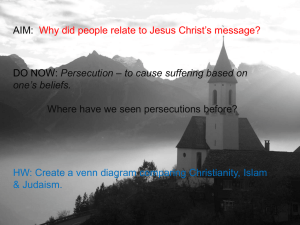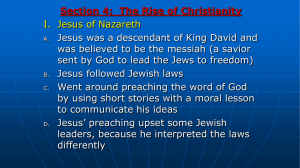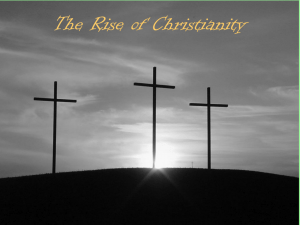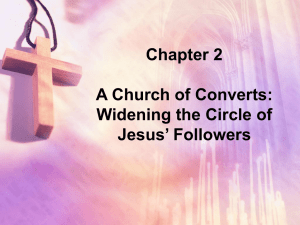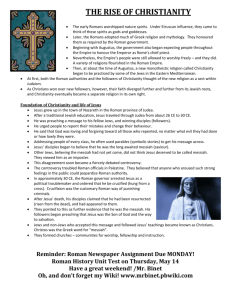Chapter 8 Lesson 1
advertisement
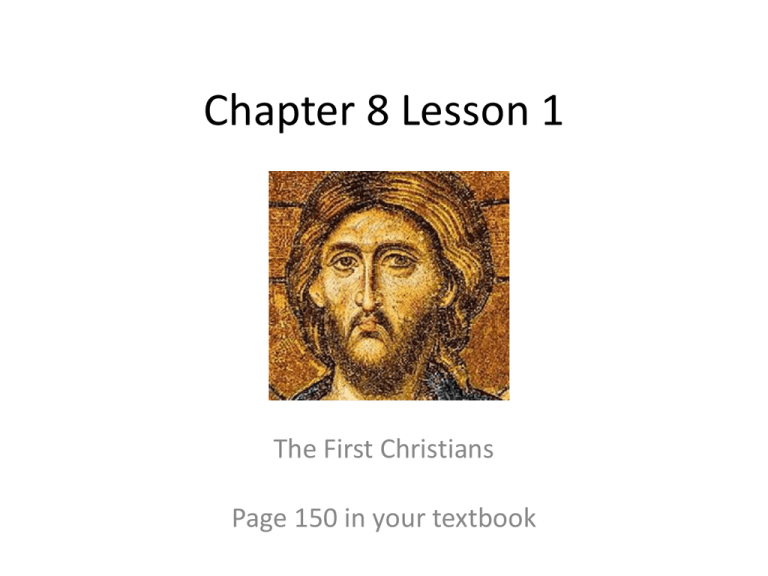
Chapter 8 Lesson 1 The First Christians Page 150 in your textbook Guiding Questions 1. What was Rome’s policy towards different Religions? 2. Why did the Jews of Judea revolt in 66 AD? What was the outcome? 3. Who was Jesus Christ and what message did he spread to his followers? Religious Toleration • Generally, Rome tolerated the varied religions in the Empire. • People allowed to worship other gods. As long as citizens showed loyalty by • 1. honoring Roman gods • 2. acknowledging the power of the emperor • Most people at the time were polytheistic, and content to worship the Roman gods along with their own. • By 63 BC, Romans conquered Judea, where most Jews of the time lived. Divisions in Judea • Jews = monotheistic • To avoid violating Jewish beliefs, the Romans excused Jews from worshiping Roman gods. • some Jews rejected Roman traditions and called for strict obedience to Jewish laws and traditions. • These strict followers of Judaism were called Zealots. Zealots • Most Jews were reluctantly willing to live under Roman rule. • Others, called Zealots, were not. • They encouraged Jews to revolt against Rome and reestablish an independent state. • Some Jews believed a messiah, or anointed king sent by God, would soon appear and lead the Jewish people to freedom. Jewish Revolt • In 66 AD, discontent flared into rebellion. • Roman forces under command of emperor Titus • Romans crushed the rebels, captured Jerusalem, and destroyed the Jewish temple (built 957 BC). Destruction of the Temple Remains of the Temple Section of Arch of Titus Masada • Survivors escaped to Masada, an ancient fortress in the south of Israel, overlooking the Dead Sea. • the First Jewish–Roman War ended in the mass suicide of the 960 Jewish zealots and their families hiding there. Masada Jewish Revolt • When revolts broke out in the next century, Roman armies destroyed Jerusalem. • Thousands of Jews were killed in the fighting and many others were enslaved and transported to various parts of the empire. Roman Destruction of Jerusalem Bellringer • What was Rome’s policy towards different religions in the empire? • Was this an effective policy? • Can you provide an example of a religious group that did not follow this policy? What happened to them? Rise of Christianity • A few decades before the revolt, a Jewish teacher named Jesus traveled and preached throughout Judea and Galilee. • Was also said that Jesus performed miracles (cures, exorcisms, resurrection of the dead and control over nature) • Jesus’s teachings began as a new movement within Judaism. Teachings of Jesus • Jesus called for the transformation of the inner person: • “So in everything, do to others what you would have them do to you, for this sums up the Law and the Prophets” • Jesus said “Love the Lord your God with all your heart and with all your soul and with all your mind and with all your strength. Teachings • Jesus shared these ethical concepts with other Jewish teachers, but he gave them an especially eloquent expression. • These concepts – humility, charity, and love towards others – later shaped the value system of western civilization. • Jesus’s preaching stirred controversy • Some people saw him as a revolutionary who might lead a revolt against Rome • His opponents finally turned him over to Roman authorities • The procurator Pontius Pilate ordered Jesus’s crucifixion. • Occurred approximately 30-36 AD Followers • After the death of Jesus, his followers proclaimed that he had risen from the dead and had appeared to them. • They believed Jesus to be the Messiah, the long expected deliverer who would save Israel from its foes and bring in an age of peace and prosperity. Christianity Spreads • Prominent apostles (leaders) arose in early Christianity. • Peter, a Jewish fisherman who followed Jesus, became the leader of the apostles. • Paul was another major apostle. • Paul spread the word of Christ to non Jews. • Paul founded Christian communities in Asia minor and along the shores of the Aegean. The 12 Apostles Paul’s message • The center of Paul’s message was that Jesus was the Savior, the Son of God, who had come to earth to save humanity • Paul taught that Jesus’s death made up for the sins of all humans. • By accepting Jesus as Christ (from Christos, the Greek term for Messiah) and Savior, people could be saved from sin and reconciled to God. Teachings • The teachings of early Christianity were passed on orally through preaching • Paul and other followers of Jesus wrote letters outlining Christian beliefs for communities around the eastern Mediterranean • Between 40 AD and 100 AD, these accounts became the basis of the written Gospels • The Gospels: record of Jesus’ life and teachings, form the core of the New Testament, the second part of the Christian Bible. • By 100 AD, Christian churches had been established in many major cities of the empire. • Most early Christians came from the Jews and Greek speaking populations of the east. • In the 2nd and 3rd centuries, an increasing number of followers were Latin speaking. Roman Persecution • Many Romans came to view Christians as harmful to the Roman state. • Christians refused to worship Roman gods and emperors • Romans saw this refusal as treason, punishable by death. • Christians believed there was only one god. To them the worship of many gods endangered their own salvation. • The exemption given to Jews to practice monotheism was not extended to Christians. Persecution • Persecution of Christians by Romans didn’t stop its growth • It served to strengthen Christianity by forcing it to become more organized. • Fear of persecution meant that only the most committed would follow the faith. Why was Christianity able to gain so many followers? • 1. The Christian message: • Had a lot to offer the Roman world. • Roman based religion was impersonal and existed for the good of Rome. • Christianity was personal and offered salvation and eternal life to individuals. • Christianity gave life a meaning and purpose beyond the state and material things. • 2. Christiantiy


